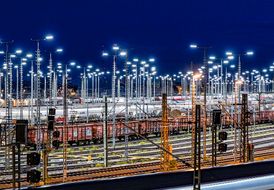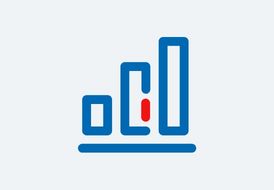Income development
The economic development of DB Group continued to be shaped by the impact of the Covid-19 pandemic on passenger transport and the strong development of our transport and logistics activities. Operating profit figures again recorded a noticeable improvement. In passenger and rail freight transport, however, the situation remained under pressure:
- In the Integrated Rail System, revenue growth exceeded additional expenses from higher personnel expenses (capacity expansion and wage increases) and cost of materials (including higher energy expenses due to volume- and tariff-related increases), owing mainly to the recovery of demand in passenger and rail freight transport as well as the effects of countermeasures. The wage dispute with the GDL and the consequences of the floods also curbed this development.
- The operating profit development at DB Schenker was once again very strong, driven primarily by the development in air and ocean freight.
- DB Arriva also recorded a significant recovery in its operating profit figures.
Additional information is available in the section Development of business units.
- Special issues are eliminated in the adjusted statement of income. The transition to the adjusted statement is a two-step process: firstly, standard reclassifications are carried out, then the figures are adjusted for individual special items.
- The reclassifications essentially relate to two issues.
- The first issue is the reclassification of net interest income components not related to net financial debt and pension provisions: predominantly the compounding and discounting effects of non-current provisions (excluding pension obligations) and non-current liabilities (excluding financial debt). The non-operational character of these components can also be seen in the fact that their influence on net interest income very much depends on the interest rates as of the balance sheet date.
- The second significant reclassification relates to the amortization of intangible assets capitalized in the course of purchase price allocation (PPA) of acquisitions conducted during the assessment of long-term customer contracts. Existing transport contracts are an essential component of the purchase price valuation, in passenger transport in particular. In order to safeguard the operating assessment and to prevent these contracts from being treated differently from other contracts, these amortization components are eliminated from the operating profit. The amount reclassified resulted mostly from acquisitions in the DB Arriva business unit.
- Adjustments for special items involve issues which are extraordinary based on the reasons for them and/or the amounts involved, and which would effect a material change on operating development over time. Book profits and losses from transactions with subsidiaries/financial assets are adjusted regardless of their amounts. Individual items are adjusted if they are extraordinary in character, can be accounted for and assessed precisely, and are significant in volume.
| TRANSITION TO THE ADJUSTED STATEMENT OF INCOME / € million | 2021 | Reclassi- | Adjust- | 2021 | 2020 | Change | 2019 | ||||
absolute | thereof | thereof | % | ||||||||
Revenues | 47,075 | – | 175 | 47,250 | 39,902 | +7,348 | +33 | +36 | +18.4 | 44,431 | |
Inventory changes and other internally produced and capitalized assets | 3,884 | – | – | 3,884 | 3,564 | + 320 | +7 | +0 | +9.0 | 3,166 | |
Other operating income | 5,901 | – | –2,179 | 3,722 | 3,391 | + 331 | –4 | + 9 | +9.8 | 3,008 | |
Cost of materials | –28,419 | – | 20 | –28,399 | –22,683 | –5,716 | –5 | +13 | + 25.2 | –22,259 | |
Personnel expenses | –19,219 | – | 93 | –19,126 | –18,167 | – 959 | –33 | –36 | +5.3 | –18,011 | |
Other operating expenses | –5,716 | – | 672 | –5,044 | –5,005 | –39 | +2 | –19 | +0.8 | –4,899 | |
EBITDA | 3,506 | – | –1,219 | 2,287 | 1,002 | +1,285 | +0 | +3 | + 128 | 5,436 | |
Depreciation | –3,804 | 39 | –74 | –3,839 | –3,905 | +66 | –6 | –6 | –1.7 | –3,599 | |
Operating profit/loss (EBIT) | EBIT adjusted | –298 | 39 | –1,293 | –1,552 | –2,903 | +1,351 | –6 | –3 | –46.5 | 1,837 | |
Net interest income | Operating interest balance | –528 | 22 | 42 | –464 | –541 | +77 | +0 | –1 | –14.2 | –620 | |
Operating income after interest | –826 | 61 | –1,251 | –2,016 | –3,444 | +1,428 | –6 | –4 | –41.5 | 1,217 | |
Result from investments accounted for using the equity method | | –10 | 2 | – | –8 | –20 | +12 | – | +0 | –60.0 | –9 | |
Other financial result | 48 | –24 | – | 24 | –165 | + 189 | –0 | –2 | – | –72 | |
PPA amortization customer contracts | – | –39 | – | –39 | –55 | +16 | – | +0 | –29.1 | –62 | |
Extraordinary result | – | – | 1,251 | 1,251 | –1,800 | +3,051 | – | +2 | – | –393 | |
Profit/loss before taxes on income | –788 | – | – | –788 | –5,484 | +4,696 | –6 | –4 | –85.6 | 681 | |
Taxes on income | –123 | – | – | –123 | –223 | +100 | +0 | +2 | –44.8 | –1 | |
Actual taxes on income | –302 | – | – | –302 | –180 | –122 | – | – | +67.8 | –137 | |
Deferred tax expense (–)/income (+) | 179 | – | – | 179 | –43 | + 222 | – | – | – | 136 | |
Net profit/loss for the year | –911 | – | – | –911 | –5,707 | +4,796 | –6 | –2 | –84.0 | 680 | |
DB AG shareholders | –946 | – | – | –946 | –5,710 | +4,764 | – | – | –83.4 | 662 | |
Hybrid capital investors | 26 | – | – | 26 | 26 | – | – | – | – | 5 | |
Other shareholders (non-controlling interests) | 9 | – | – | 9 | –23 | +32 | – | – | – | 13 | |
Earnings per share (€ per share) | |||||||||||
Undiluted | –2.20 | – | – | –2.20 | –13.28 | +11.08 | – | – | –83.4 | 1.54 | |
Diluted | –2.20 | – | – | –2.20 | –13.28 | +11.08 | – | – | –83.4 | 1.54 | |
Overall, income development was very positive:
- The significant increase in revenues was primarily driven by the development of DB Schenker. Overall, a growth in revenues was again recorded in the Integrated Rail System.
- Other operating income also increased. This was mainly due to changes in provisions (including for impending losses), increased subsidies, including at DB Netze Stations from the economic stimulus package and DB Cargo primarily for facility price support and increased scrap revenues at DB Netze Track. In contrast, the Covid-19-related support services received from the industry solution for regional transport at DB Regional decreased somewhat.
Expenses also increased significantly, due in particular to the business development at DB Schenker and higher personnel expenses in the Integrated Rail System, though overall this increase was disproportionately small compared to income:
- Cost of materials increased noticeably, primarily driven by an increase in purchased transport services and higher freight rates at DB Schenker. In the Integrated Rail System, the main factors were a price- and volume-related increase in expenses for energy, maintenance and winter services, and a volume-related increase in purchased transport services at DB Cargo. At DB Arriva, higher expenses for energy, among other things, were almost completely offset by cost-reducing effects from the cessation of the Rail North franchise (ARN franchise).
- Personnel expenses also increased. In addition to wage effects, the higher number of employees also impacted the Integrated Rail System. There were additional effects at DB Schenker from the positive development of business operations. At DB Arriva, expense-reducing effects from the cessation of the ARN franchise were more than compensated by negative exchange rate effects, among other things.
- Other operating expenses were close to the previous year’s level. Higher expenses for purchased services resulting from volume development at DB Schenker and expenses related to flood damage at DB Netze Track were almost completely offset by, among other things, the effects of the cessation of the ARN franchise at DB Arriva. Lower additions to provisions for impending losses at DB Regional and DB Arriva also had a cost-reducing effect.
- Depreciation fell slightly. At DB Arriva, the cessation of the ARN franchise had an expense-reducing effect. In the Integrated Rail System, higher depreciation resulting from capital expenditures was more than offset by the countereffects of vehicles reaching the end of their useful life, among other things.
Adjusted EBIT and adjusted EBITDA improved noticeably as a result.
- The development of interest rates supported the positive development of the operating interest balance.
Operating income after interest also improved, but remained negative.
- Net investment income remained at a very low level, and the change was mainly driven by lower losses at GHT Mobility GmbH
- The increase in the other financial result was mainly due to the net positive sum from hedging transactions and the increase in value of other investments from fair value assessment.
- Extraordinary result improved significantly, driven by the implementation of Covid-19-related train-path price support particularly at DB Long-Distance, and had a strong overall positive effect. This was curbed by the effects from the adjustment of provisions (in particular for ecological burdens and in connection with civil proceedings on infrastructure fees). In 2020, significant extraordinary charges, particularly for impairments at DB Arriva were recorded.
| EXTRAORDINARY RESULT / € million | 2021 | thereof | 2020 | thereof | |
DB Long-Distance | 1,826 | 1,826 | 1 | 1 | |
DB Regional | 2 | 2 | –4 | –4 | |
DB Cargo | 237 | 237 | –13 | –13 | |
DB Netze Track | –243 | –201 | –142 | –141 | |
DB Netze Stations | – | – | 3 | 3 | |
DB Netze Energy | –19 | –19 | –72 | –72 | |
Other/consolidation | –639 | –639 | –193 | –193 | |
Integrated Rail System | 1,164 | 1,206 | –420 | –419 | |
DB Arriva | 1 | 1 | –1,380 | –1,380 | |
DB Schenker | 75 | 75 | 0 | 0 | |
Consolidation other | 11 | 11 | 0 | 0 | |
DB Group | 1,251 | 1,293 | –1,800 | –1,799 | |
thereof reimbursements | 2,098 | 2,098 | – | – | |
thereof additions to provisions | –515 | –515 | – | – | |
thereof impairment of goodwill | – | – | –1,411 | –1,411 | |
Despite the growth, profit before taxes on income remained negative, but again increased significantly. The income tax position improved:
- Actual income taxes rose due to higher results for some foreign Group companies.
- The significant increase in deferred tax income (previous year: deferred tax expense), which more than compensated for this, resulted primarily from changes to estimates with regard to the future use of loss carry-forwards.
The net loss for the year (loss after income taxes) also recovered noticeably, but remained negative.



